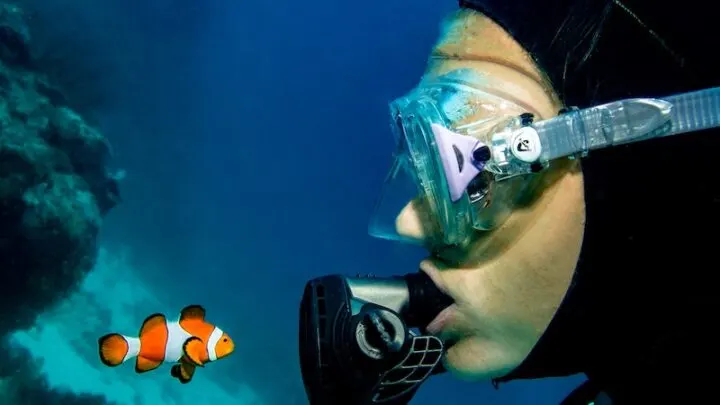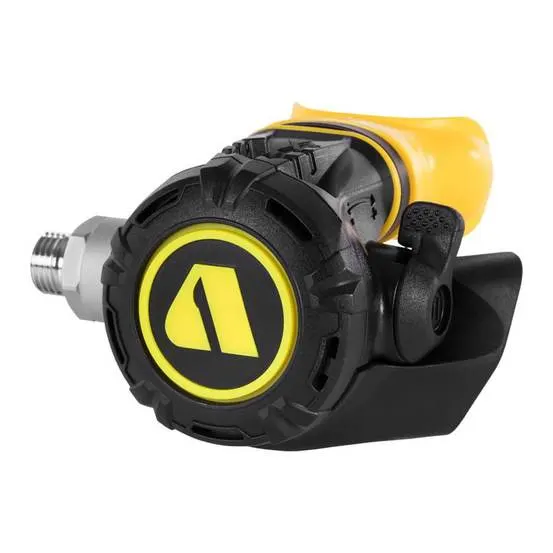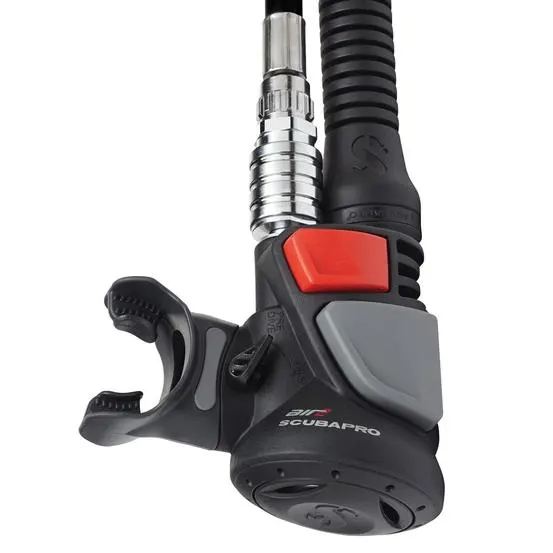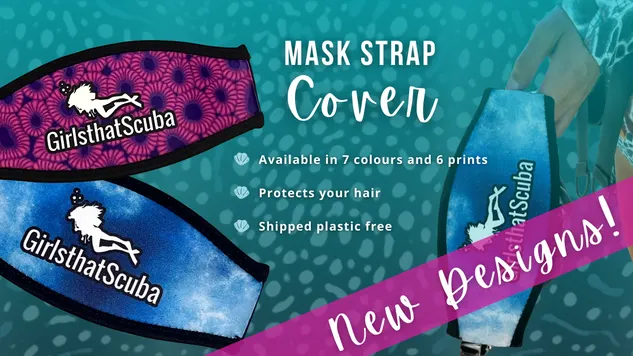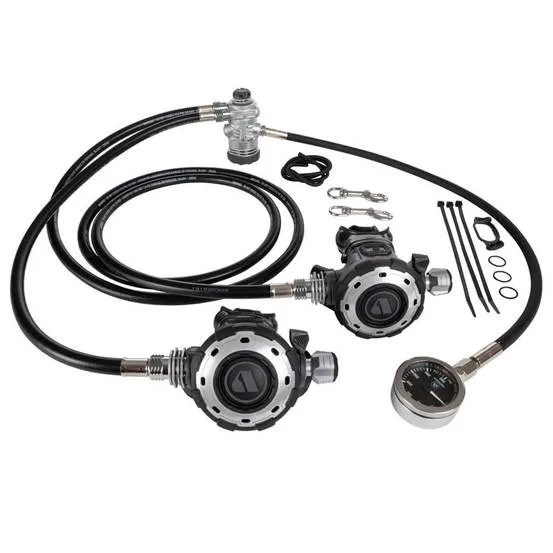When you complete your entry level dive courses and start scuba diving a little more regularly, you soon start to notice that another diver’s alternate air source configuration might be different from the one you first learned with.
There’s the traditional bright yellow octopus, to the integrated AIR (Alternate Inflator Regulator) and the long regulator hose configuration to consider. But which alternate air source configuration is right for you?
We’re here to break down the pros and cons of different alternate alternate air configurations. We’ll discuss the long hose vs short hose debate, and explore whether the AIR is safe for scuba diving. Read on to learn how each of these secondary regulator setups works, and which is best for different types of diving. We’ll also discuss the safety considerations of each setup in an out of air scenario.
Octopus – Pros
Perhaps the most recognisable alternate second stage setup is the octopus or secondary regulator. In this setup, the alternate second stage reg is on a slightly longer hose (usually 90-100cm/30-40 inches) than the primary second stage and the hose is often yellow.
The regulator itself is generally yellow, too. It’s widely taught that the reg should be attached to the diver somewhere within a “golden triangle” or “triangle of safety”. This is formed by the chin and the two lower points of the rib cage.
This approach is favoured by most divers for a number of reasons. This is the system taught in most entry level courses, meaning it’s familiar to most scuba divers. In an emergency we rely heavily on familiarity and muscle memory so the standardisation of this system is hugely advantageous. If the octopus is identifiable by its bright colour and placement, this should remove confusion in a panicked diver situation.
The familiarity of this system is also helpful to divers who rely on rental equipment. Theoretically, you can pick up a set of rental gear anywhere in the world and expect a similar setup. This is also helpful to those who regularly dive with different buddies in new and varied locations.
Octopus – Cons
Standardisation goes a long way to helping out in out of air scenarios, but the octopus setup has its drawbacks. We’ve all seen (and probably been) that diver with a loose alternate air source. It’s a never ending quest to find a perfect octopus attachment to secure your alternate regulator to your BCD.
These attachments can be temperamental and some can come loose during dives. This causes damage to both the equipment and the underwater environment. Additionally, those who favour the Alternate Inflator Regulator (see below) often claim that the weight of an extra hose and regulator is a barrier to lightweight dive travel.
One of the biggest drawbacks to the octopus setup relates to an important safety consideration. In an out of air scenario it is widely believed that a panicked buddy will logically reach for the regulator in your mouth. Their brain is safe in the knowledge that the regulator you’re breathing from is working.
This then leaves you to breathe from your own octopus. It makes the additional length on the octopus hose redundant, and causes a tricky scenario. You have to stay extremely close to the panicked diver in order to both breathe from your gas supply. For more on this, read on to the pros and cons of the long hose configuration.
AIR (Alternate Inflator Regulator) – Pros
An AIR, short for Alternate Inflator Regulator, is a compact regulator built into the inflator and deflator at the end of your BCD hose. In use, you would donate your primary regulator to an out of air diver. You then switch to breathing from the AIR yourself.
Travelling divers in particular are huge advocates of this system. By combining your BCD inflator and your alternate air source, you’re eliminating the weight of an entire hose and a second stage regulator. Some also feel that without the additional hoses they have more freedom to move around and less risk of entanglement. You also avoid the issue of your alternate air source dragging and causing damage to the reef (and the equipment).
There’s some muscle memory which works in your favour with the AIR, too. As you’re already regularly reaching for your inflator hose during a dive to adjust your buoyancy, the AIR is easy to find in an emergency situation.
AIR (Alternate Inflator Regulator) – Cons
Choosing a slightly less conventional setup can make things a challenge if you’re not regularly diving with the same buddy. If you choose this setup, it’s imperative that you explain the system and the donation process to your buddy before every dive as part of your thorough pre dive safety checks.
There can also be some challenges with Alternate Inflator Regulators when it comes to servicing and compatibility. Ideally both your primary and alternate regulators should be from the same brand. When it comes to an AIR you’ll also want the brand to match your BCD for the best compatibility.
If your AIR is a different brand from your BCD, there can be some connectivity issues with the corrugated hoses. This might force you to choose a BCD and regulator setup from the same brand. You may also find that your local dive store cannot service your AIR. Whenever you’re purchasing new dive gear it’s worth checking in with your local store to see if they will be able to facilitate your servicing.
As well as it being a less recognisable system, the safety of the AIR has been brought into question. Critics of the AIR note that it’s inconvenient (and perhaps even risky) to try to manage your breathing and your buoyancy from the same device during an emergency ascent. This additional task loading can further complicate a potentially difficult situation.
Finally, if you don’t explain the AIR system thoroughly to your buddy, or if you’re approached by a diver who isn’t you own buddy, this could cause issues. A panicked diver seeking out a familiar octopus setup may panic more if they can’t find the identifiable colour and placement.
Long Hose Alternate Air Source Configuration – Pros
The long hose configuration is traditionally associated with more technical diving setups such as twinset and sidemount diving. However, some training agencies such as GUE (Global Underwater Explorers) now teach this setup from entry level courses.
In a long hose setup, the primary second stage regulator is on a long hose (around 150cm/60 inches). This is routed under the diver’s right arm, across the chest, around the neck and into their mouth with an angled swivel hose. Their alternate second stage is on a much shorter hose. This is worn on a necklace so that it’s easily accessible under the diver’s chin. To donate to an out of air buddy, the diver would donate the regulator from their mouth and switch to the alternate on the necklace.
Fans of the long hose configuration claim that, thanks to its roots in technical diving, learning with a long hose means that you’re training the “right way” from the beginning. This is particularly valuable if you see yourself moving down a technical diving path in the future.
As mentioned, panicked divers will often reach for the regulator which is already in their buddy’s mouth, therefore a long hose configuration is much safer. Similarly, the short hosed alternate regulator is considered safer as it’s extremely close by when worn on a necklace.
Finally, the additional space provided by a long hose can only be an advantage in an out of air situation. Both the octopus and AIR setups require you and your buddy to be extremely close when completing an emergency ascent.
With the additional length of a long hose you can keep a little more distance between you. This can be helpful from a safety perspective. If your buddy is panicking, this allows you to swim more freely and remain in a trim position.
Long Hose Configuration – Cons
In contrast to the other systems, there are few drawbacks to the long hose configuration. The biggest consideration is training and regularly drilling skills. It can be challenging to become familiar with the steps involved in correctly donating a long hose and switching to the alternate.
However, all divers should be practicing their skills regularly – regardless of setup. Therefore this point can be applied to any alternate air source configuration.
As with the AIR, it’s important that you communicate well with any new buddy to inform them that you have a long hose. Remind them that the regulator in your mouth is the one you will donate in an out of air scenario.
Finally, there is a small amount of additional weight associated with the extra length of the hoses so it may not be the best choice for travelling divers. For most, though, the benefits of the long hose outweigh the inconvenience of an extra few hundred grams of hose.
So which configuration should I choose?
As with all scuba equipment choices, every diver should choose the system which will best serve their own diving needs. Take into account your diving activities, future plans (travel or technical courses), and the pros and cons of each system. This should help you make an informed decision.
Remember that it’s always important to seek thorough training on any equipment setup which is unfamiliar to you. Reach out to your local dive provider, or search our Girls that Scuba Together group to find a local instructor.
What alternate air source setup do you use? Which system best suits your diving needs? Let us know in the comments below or share your equipment configuration with us on Instagram (we’re @girlsthatscuba) and in the Girls that Scuba Facebook community!

